Abstract
The article is devoted to the consideration of the role of ideological and cultural codes in the modern advertising discourse. The relevance of the study is determined, in particular, by the fact that modern day-to-day realities are forcing advertisers to use new communication channels and create “catchy” creatives, which are based on a deep analysis of consumers behavior, their habits, stereotypes and, as a result, the semiotic communication system. The communication policy of the company, built on the provocative breakdown of gender stereotypes, is examined using the material of advertising texts of the Dove brand through a semiotic analysis. The brand has earned community approval and increased sales using triggered messages and visuals featuring average women. The authors pay special attention to the fact that Dove created all advertising campaigns according to the local peculiarities and used images of women typical for this region in different countries. This is an important aspect, because for the necessary communication and economic efficiency, advertisers need to take into account the cultural codes of each country. It is also noted that as a result, the brand has developed its social aspect, which has become one of the main channels of communication with potential consumers – women of all ages. The studied brand was able to achieve important economic and communication goals, i.e., to stand out from competitors, increase sales and become better known with the help of social coloring of communications, non-standard solutions and the use of the laws of semiotics.
Keywords: Cultural codes, gender stereotypes, ideological codes, provocative advertising, semiotic analysis, semiotics of advertising
Introduction
Nowadays, mass culture has become an integral part of society. The phenomenon of advertising penetrates into the life of every modern person, becoming an irreversible reality. Over the past few decades, advertising has shown rapid change and tremendous growth, finding new ways of presenting information and covering topics that were not previously touched by manufacturers of goods and services. Today, the attention and loyalty of the consumer can be retained not only by catchy texts and photographs, but also by the very idea of the importance of the brand in the life of society and a particular person. Thanks to its large range, advertising influences consumers behavior by broadcasting a certain lifestyle: it fixes a certain set of values, ideals, stereotypes and preferences in the minds of the audience. The semiotic approach to the analysis of advertising communication allows us to examine in more detail the interaction of the consumer with the advertising message, describe the processes of encoding and decoding information, and identify the mechanisms for creating effective advertising (Bati, 2007; Beasley & Danesi, 2010; Brame, 2018; Brame & Jashari, 2018; Lawlor, 1992).
Problem Statement
Advertising, as one of the most important spheres of human activity and society as a whole, is based on the semiotic properties of culture as a complex system. The cultural code appears as an initial sign structure, a kind of matrix containing ... all the components of the cultural paradigm of the people and their behavior from the point of view of the semiotic approach (Zubko, 2004). U. Eco understands cultural codes as an etiquette, which is a system of gestures and conventions, hierarchies, etc., a system of modeling the world, where myths and legends are combined, creating a picture of the world view from the standpoint of a separate community and a typology of cultures (Eco, 2004, p. 405).
Bukina determines the cultural code as “a set of information markers that allow a person to adequately perceive the spatiotemporal processes occurring in culture and adequately respond to them, because each cultural code is an element of the human psyche” (Bukina, 2010, p. 236; Bukina, 2008). Thus, the cultural code can be considered as an element of the mentality of a particular human community.
Ideological codes imply reliance on ideologemes, mythologemes, and religiogemes, which makes this type of semiotic codes a significant component of advertising discourse (Adzovie et al., 2019; Ahmed et al., 2020; Asci, 2018; Gandhi, 2020; Terskikh, 2019; Wetzel, 2020).
Practice shows that advertising codes work in two ways: follow established stereotypes or contradict them. However, both scenarios are equally difficult, because in the first case, the advertising message needs to find an approach to the audience so that it would see the familiar and understand the indicated problem. In the second case, it is important to find your audience and not cross the border. Let's take a closer look at examples.
P&G's “Thank You, Mom” commercials are the perfect example of a mother-stereotype code. In the videos, we see different women who support their children and do everything possible for their development. We are shown women willing to sacrifice time, health, even life for the success of their child. This advertising campaign is “doomed to succeed”: a clear message, high-quality production and the use of a loving mother's code build an analogy and a strong connection with the P&G brand. Consumers now know that they are being cared for in the same way as a loving mother does.
A rich in contrast example was the Nike video “What are our girls made of?”, focused on the Russian market, timed to coincide with the start of the “Made from ...” advertising campaign. The main character of the video is a girl who performs on stage with the famous song “From what, from what...”. The moment she comes to describing girls, what exactly they are made of, she stops to think about it. Suddenly athletes enter the hall and inspire her to change the Soviet lyrics of the song to a new one; the commercial is designed to emphasize the infinity of possibilities for women and help them to believe in themselves. Video “What are our girls made of?” was specially filmed for Russia. But what would be the reaction if it was shown, for example, in a Muslim country, where the code of perception of a woman is radically different from ours? Therefore, it is important to understand who the target audience is, what traditions, customs, perceptions it has, and which codes will help in achieving their goals, when developing advertising campaigns.
Dove shows an excellent example of breaking stereotypes about a woman's appearance. Far from reality images are often used in commercials and on the covers of magazines. These images do not go along with real women so much that consumers, namely women, stop seeing themselves in them. In recent decades, advertising aimed at women has turned out to be one of the most popular brand promotion tools in the world; Russia also joined this trend.
For years, the advertising market has indeed seen women as exclusively naked bodies or sex objects. According to Dove research, about 71% of women would like to see images of different women in the media: women of all ages and sizes. Based upon this stereotype, Dove has created a massive campaign called #Show Us. #Show Us is a collaboration between Girlgaze, a community of women photographers and Getty Images, one of the world's largest supplier of stock images, editorial photography and etc. Any woman could take part in the project, regardless of age, hobbies, lifestyle, nationality, etc. The photographs of these women were uploaded to the stock photography without retouching, editing or other additional processing. In the future, this stock can be used for various advertising campaigns. Today the Getty Images contains more than 10,000 photographs. This project is a clear example of how you can break some stereotypes in advertising, armed with consumer support.
Other brands have taken up the idea of supporting women following Dove example. For instance, Pantene in 2013 talked about sexist labels that are attached to women: where a man is called persistent, a woman is considered arrogant. A year later, the video “Not Sorry” was released, drawing attention to the fact that women are used to apologizing all the time, even in situations where they violate their own boundaries. Finally, in 2014, the legendary Always #LikeAGirl was released at the Super Bowl, calling for a rethinking of the phrase “like a girl”: “Why doesn't running like a girl mean “winning the race”?”
Advertising that speaks respectfully to women and encourages them to feel stronger and bolder often turns out to be beneficial for the brand itself. The most striking examples here are Dove and Nike: in 2014, Dove income grew from $ 2.5 billion to $ 4 billion, while Nike rose 15% quarterly, mostly because the brand specifically appeals to a female audience. Even the highly publicized and perceived ambiguously Russian version of Reebok's #nivkakeramki ad (#completely out of line ad), increased the company's sales: the Ozon online store said that Reebok products were sold by 20% more from February 8 to 10, 2019, and the Lamoda retailer announced an increase in demand for sports goods in general, where the popularity of Reebok increased the most: by 57%.
Research Questions
The main research questions of the study are as follows:
- What is the role of verbal and visual ideological and cultural codes in modern advertising?
- What are the specific features of using cultural and ideological semiotic codes in brand Dove advertising?
- How do advertisers adapt advertising messages to culture and ideology of different countries?
Purpose of the Study
The purpose of this study is to analyze the role of cultural codes in advertising communication. Cultural codes in advertising are designed to reflect the needs of a person and society or create them through the lens of mentality. It can be difficult, because it is not always enough to shoot a beautiful video. It is important to choose memorable images that consumers will associate themselves with and agree with a posed problem.
Research Methods
To reach the purpose of the research the author employed the following research methods:
- Methods of systematization and theoretical generalization.
- Descriptive analytics.
- Semiotic method of analysis.
- Method of contextual analysis.
Findings
Much of Dove advertising today is about breaking certain stereotypes. Based on the research carried out by the ideologists of the brand, it was decided to go along with changing the women perception of themselves and the outside world by making a certain revolution in their minds. Representatives of the brand realized that many women suffered from low self-esteem because of the fashion for ideal beauties: they were surrounded by ideal and physically perfect images from magazine covers and from commercials, so average women faced denial of their own identity. The mission of the new campaign for true beauty was formulated as follows: “Make women feel more beautiful every day by expanding the stereotypical vision of beauty, and inspire women to take better care of themselves.” Over the course of several months, the company has developed a number of creative ideas for an advertising campaign: “Beauty has a million faces, one of them is yours”, “Give wings to your beauty” and “Let's be friends with beauty”. However, experiment showed that women did not support the idea of the company, considering it too intrusive, preaching, trying to change themselves, and not the world around them. After the first unsuccessful attempt, it was decided to go the other way - from the product. For the main product in the advertisement, they took the Dove Firming line of products for problem areas. The new creative was based on the idea: “With Dove Firming, women can flaunt their feminine forms.” While other companies have based their ads on the idea of perfect beauty, Dove has relied on the opposite: beauty in all its forms, including different shapes, sizes and types.
It is important to emphasize that the company took into account the cultural codes of those countries in which the commercial was broadcasted; it aimed at breaking stereotypes. In February 2006, Dove advertising campaign entered the Arab markets (UAE, Saudi Arabia, Kuwait, Palestine), but in a modified format - in a “modest” version that did not violate the religious and cultural traditions of the region. In advertising messages, there were no images not only of half-naked bodies, but also of female figures in general, and the hair of the models was covered in accordance with the religious canon.
In Russia, Dove had to abandon the main line of its revolutionary campaign - breaking stereotypes. At that time, Russian women were not ready for such drastic changes. So, it was decided to change the layout depicting overweight women who advertised a line of products against cellulite. The producers were cautious, deciding that such provocative images would be incomprehensible to Russian women. It was decided to change the advertising images for 96-year-old Irene Sinclair. In a demographically aging Europe, the elderly population is an active and solvent consumer audience, but Russian pensioners did not meet these requirements and did not fit the target audience of the product in the country. This is how a more delicate creative with 57-year-old Larisa Sysoeva appeared in the advertisement. The images of a bald girl and a woman with a disproportionately long nose were also considered too shocking for the Russian audience. As a result, neutral images of a girl with freckles and a plump woman appeared before Russian consumers.
The idea of fighting for the right of every woman to look not like in the “picture”, but the way she wishes, corresponds to the general trends of recent years – feminism and body positivity. Almost all of the company's advertising in recent years is femvertising. Dove addresses women and challenges gender roles and stereotypes in society.
It is safe to say that the brand deals with socially significant issues, which, in turn, have a positive impact on sales, revenue, recognition, and most importantly, on the loyalty of current and future customers. Over the years, the Dove brand has had many notable advertising campaigns supporting women regardless of age. Most of the projects listed below continue the Real Beauty campaign, launched in 2004. These projects reveal low self-esteem in women, caused by dissatisfaction with their appearance, and urge to change it.
“Real Beauty”, 2004 (figure 01).
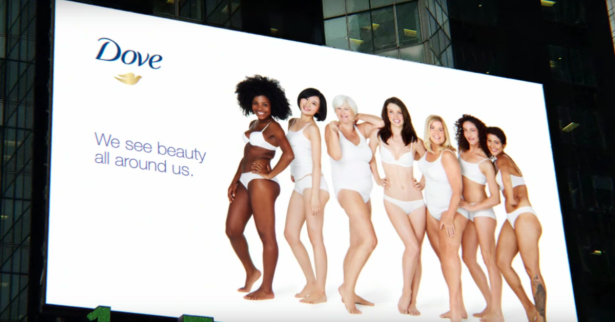
In 2004, Dove launched Real Beauty campaign the one that caused a great stir. It all started with an exhibition featuring the work of 67 women photographers, and since then, advertising campaigns based on combating beauty standards and women's self-doubt have become its hallmark. Visual codes play a primary role here.
“Sketches”, 2004.
In the Sketches project, an artist painted two portraits of women. One – according to their own description, the second – according to the description of the observer (figure 02). After the experiment, both portraits were shown to the “models”. In sketches, drawn at the instructions of the women under test, they were depicted more wrinkled or plumper.
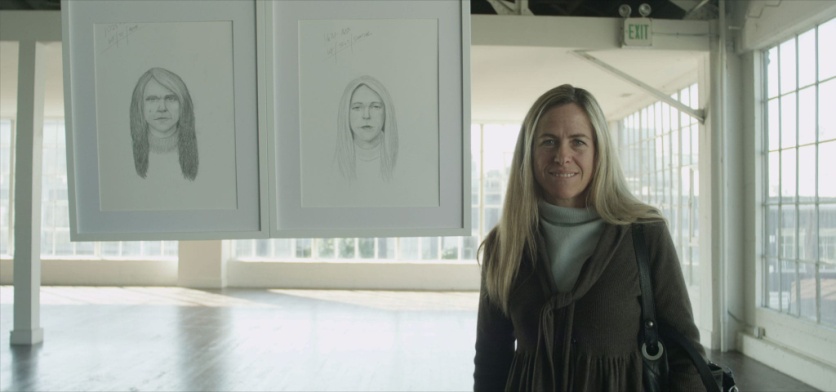
The entire campaign was based on the contrast between women's visual perception of themselves and their perception by others.
“Evolution”, 2006 (figure 03).
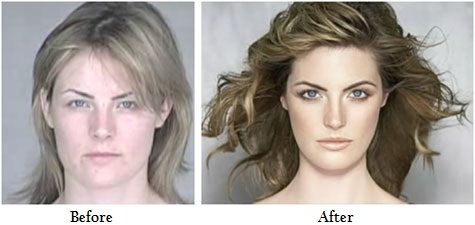
Dove showed the process of creating advertising posters that distort people's perception of female beauty. In this video, first, the girl’s makeup and hair are done and then the model is photographed. Next, the image is processed in a graphics editor, in which the illustrator changes the original proportions of the face and neck. Through this ad, the company demonstrated that the media image of beauty is fictional.
“Ad MakeOver”, 2012 (figure 04).
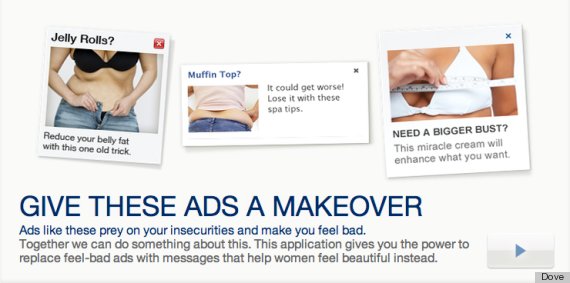
As part of the Ad MakeOver campaign, Dove enabled users to swap banner ads for complimentary messages.
According to a Dove study, 4% of women consider themselves beautiful, while the rest are often frustrated by banners with images of problematic body parts and calls to change them. For example: “”.
In the Dove Facebook app, women could choose a compliment to show to users instead of ads. There were eight choices of pleasant phrases, such as: “Every body is beautiful” and “Explosion of beauty right where you sit”.
The slogans of this campaign display verbal rhetorical codes that include subcodes of emotionally expressive means.
“Patches”, 2014.
The Dove experiment, which lasted for two weeks, showed that women's perception of their appearance depends on their beliefs. On the first day, the company invited several women to try a “revolutionary product” to improve their appearance – a patch that lasts for 14 days. Prior to the trial, psychologist at Dove asked the women what they thought about their appearance. All subjects were dissatisfied with something. Two weeks later, after the Dove product was supposed to work, the specialist again asked what women thought of themselves. They all said that they felt much better. A Dove representative then said there were no ingredients on the patch and the “change” in appearance was a result of self-belief.
“Choose Beautiful”, 2015.
In several countries, Dove has installed gates at the shopping malls entrances: “beautiful” and “average”. With the help of surveillance cameras, the company watched as the women chose which gate to go through. Many participants doubted the choice of the entrance. In the ad, Dove invited all women to choose the entrance “beautiful”, as they are, according to the brand (figure 05).
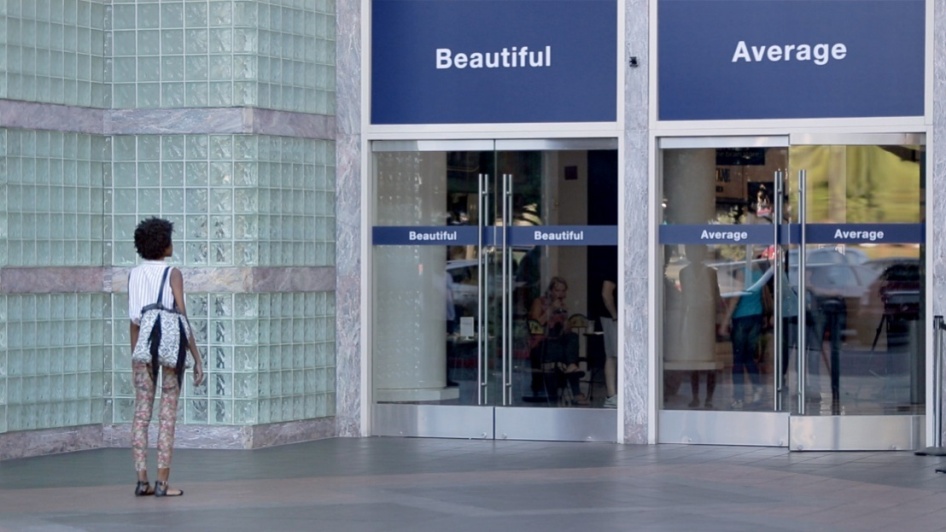
In the photo, we see only the text inviting the girl to make a choice. This is a verbal code that is the basis of communication in society. With the help of natural language, information is transmitted and the impact on the addressee is made. Without the verbal component, it is impossible to accurately and unambiguously convey the essence of the advertising message and its individual semantic components.
The brand uses various communication channels, in recent years the Internet sphere has been prevalent: various game mechanics, flash mobs on social networks, and polls. ATL channels are used to support and sell products, however, when it comes to social aspects, the brand looks for user support and information on the Internet.
The main communication of the brand with the consumer is carried out using visual means: collective images of women who have different geography, appearance, political views, religion, etc., but who are united by common problems and their solutions. At the moment, Dove is using this strategy in its advertising campaigns.
Through its example, Dove has been supporting all women in the world for many years, influencing the beauty industry and showing that social responsibility is needed not only to demonstrate, but also to create a voice and brand image.
Conclusion
In advertising, the visual semiotic code plays a primary role, since consumers first read the image, and only after that they see the verbal component of the text. At the subconscious level, a person will seek meaning, even if the image itself does not carry any signals. But these meanings can affect the ambiguity of reading, since even simple symbols can be perceived in different ways. Even at the stage of creating an idea for advertising, it is necessary to take into account the fact that a person should know both the signs and the subject area. The semiotics of advertising implies the possibility of easy interpretation of signs: otherwise, the communicative efficiency may be unattainable.
The modern consumer is a consumer of a new type. Advertisers know that audience loyalty determines many factors that can attract and retain the attention of a potential buyer. Advertising develops every day, offers new solutions and smoothly fits into certain frameworks or deliberately goes beyond them. The use of ideological and cultural codes can significantly increase the effectiveness of advertising. Dove has been fighting stereotypes about women for many years: the brand touched on the problems of anorexia in the 2000s, used average women instead of models in advertising, one of the first became body positive, etc. The company pays great attention to the adaptation of its advertising materials in different countries. All this allowed Dove to outshine its competitors and become, in a sense, an ambassador in its niche. In addition, the Dove Self-Esteem Foundation was established, a charitable organization that works with women to help them develop their identities and confront the unattainable perfect media culture that surrounds us.
References
Adzovie, E. D., Adzovie, R. H., & Boateng, E. (2019). Gender in Audio-visual Advertisement in Ghana: A Semiotics Analysis. Proceedings of the World Conference on Social Sciences, 30-42. https://www.doi.org/
Ahmed, K., Tariq, A., & Akram, A. (2020). Semiotic Analysis of the Objectification of Women in Selected Pakistani Advertisements. Journal of Communication and Cultural Trends, 2(1), 1-18. DOI:
Asci, D. (2018). Semiotics Analysis of woman image in outdoor advertisements. Ulakbilge - Journal of Social Sciences, 6(25), 715-736.
Bati, U. (2007). The semiotics of advertisements: Reading advertisements as a sign systems. Journal of Human Sciences, 4(1), 1-28.
Beasley, R., & Danesi, M. (2010). Persuasive Signs: The Semiotics of Advertising. DOI: 10.1515/9783110888003
Brame, O. (2018). Linguistic functions of Advertising in Semiotic Communication. Journal of Awereness, 3, 807-816.
Brame, O., & Jashari, A. (2018). Advertising as a Communication Element in Semiotics. UBT International Conference, 230. DOI:
Bukina, N. V. (2008). Cultural code as a language of culture. Bulletin of Chita State University, 2, 69-73.
Bukina, N. V. (2010). On the methodology of cultural codes research. Bulletin of Buryat State University, 2, 232-237.
Eco, U. (2004). The Absent Structure. Introduction to Semiotics. Symposium.
Gandhi, A. L. (2020). Semiotics analysis of Ruangguru advertising in television media. MetaCommunication: Journal of Communication Studies, 5(2), 104-114. DOI:
Lawlor, K. (1992). A semiotic reading of advertisements [Doctoral dissertation]. Dublin City University. http://doras.dcu.ie/ 18953/1/Katrina_Lawlor.pdf
Terskikh, M. V. (2019). Verbal-visual means of representing gender stereotypes in modern advertising. Scientific Dialog, 11, 86-99. DOI:
Wetzel, P. J. (2020). Intertextuality in Japanese advertising: The semiotics of shared narrative. Bonding through Context: Language and interactional alignment in Japanese situated discourse (pp. 265-281). DOI:
Zubko, G. V. (2004). Problems of reconstruction of the Fulbe cultural code (West Africa): dissertation of the doctor of cultural studies.
Copyright information

This work is licensed under a Creative Commons Attribution-NonCommercial-NoDerivatives 4.0 International License.
About this article
Publication Date
02 December 2021
Article Doi
eBook ISBN
978-1-80296-117-1
Publisher
European Publisher
Volume
118
Print ISBN (optional)
-
Edition Number
1st Edition
Pages
1-954
Subjects
Linguistics, cognitive linguistics, education technology, linguistic conceptology, translation
Cite this article as:
Terskikh, M., & Zaytseva, O. (2021). Ideological And Cultural Codes In Dove Brand Advertising: A Semiotic Analysis. In O. Kolmakova, O. Boginskaya, & S. Grichin (Eds.), Language and Technology in the Interdisciplinary Paradigm, vol 118. European Proceedings of Social and Behavioural Sciences (pp. 901-909). European Publisher. https://doi.org/10.15405/epsbs.2021.12.109

